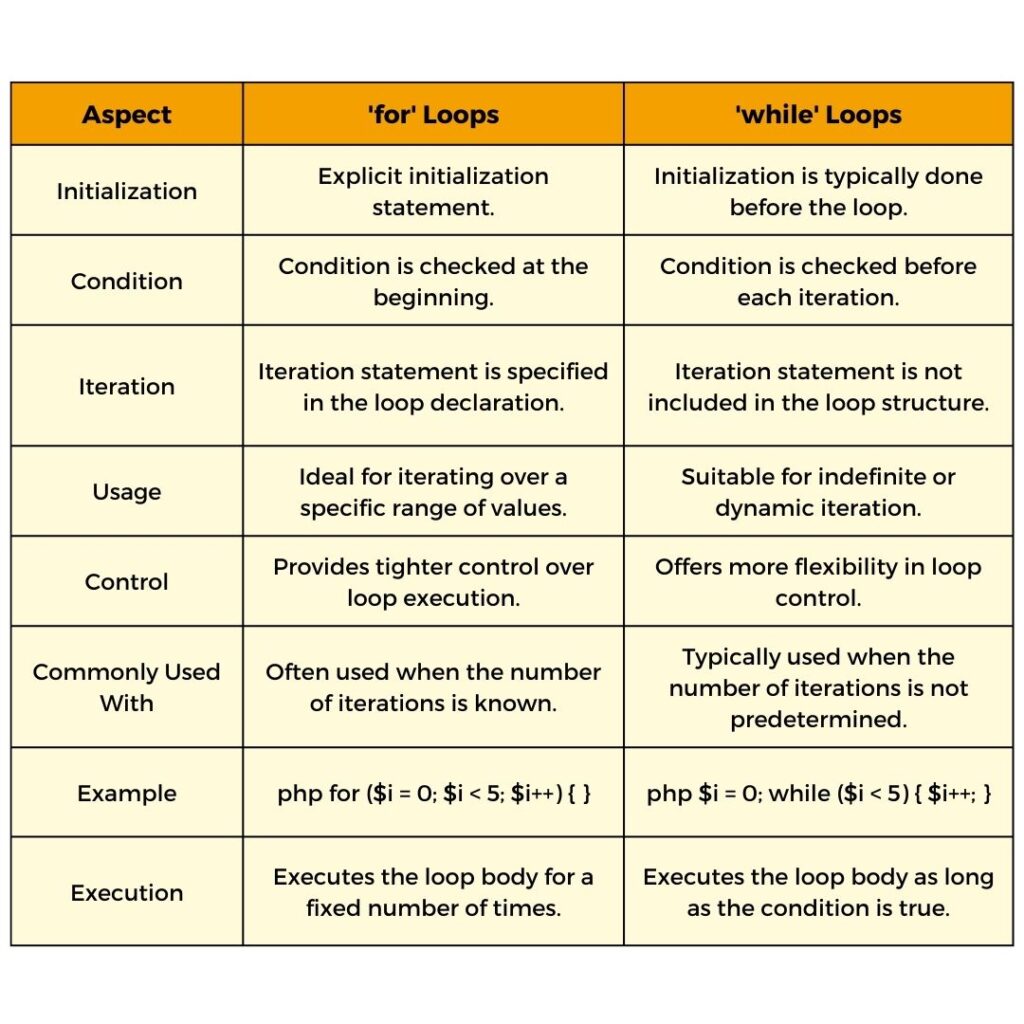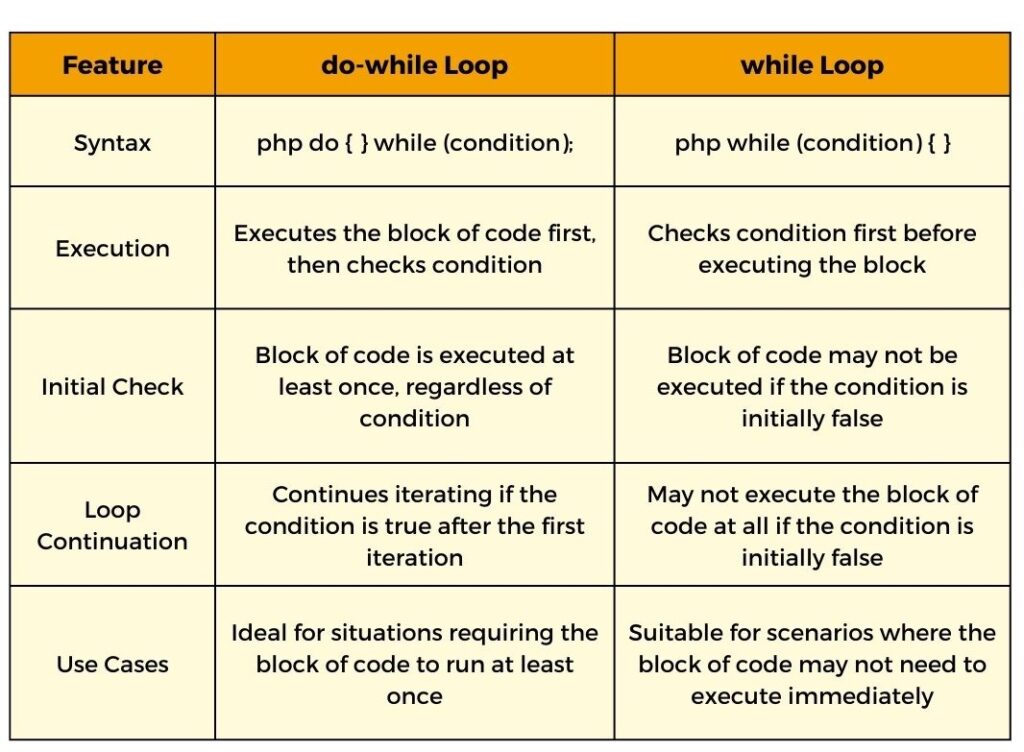If you’re just getting started with PHP development, understanding loops is essential. In this beginner’s guide, we’ll walk you through the principles of PHP loops in a simple and understandable way. Loops are like programming’s workhorses—they allow you to efficiently repeat operations without having to write the same code again and over. You will learn about many loop types, including as ‘for’, ‘while’, ‘do-while’, and ‘foreach’, as well as their syntax and usage.
Table of Contents
What are loops?
Loops are basic programming structures that allow us to run parts of code repeatedly. They allow us to automate and repeat our programmes, saving time and effort by repeatedly performing tasks.
Why are loops important in programming?
In programming, loops are important because they provide the effective handling of repeating operations. Without loops, we would have to manually duplicate the code for each iteration, resulting in redundant and error-prone code. We may simplify our code, increase readability, and reduce the possibility of errors by using loops.
Overview of PHP loops
There are various loop types in PHP, each having a unique syntax and set of applications:
- For loop: executes a block of code a certain number of times.
- While loop: Runs a block of code as long as a certain condition is true.
- do-while loop: It is similar to a while loop, except that it always executes the code block at least once before verifying the condition.
- foreach loop: Designed specifically for iterating over arrays and objects.
Understanding ‘for’ Loops
Syntax of the ‘for’ loop:
The ‘for’ loop in PHP allows you to iterate over a range of values or elements in an array in a simple manner. It has three parts: initialization, condition, and increment/decrement.
for (initialization; condition; increment/decrement) {
// code to be executed
}
- Initialization: This section sets up a loop control variable or counter. Typically, it sets the loop’s starting value.
Condition: The loop continues to execute as long as this condition is true. When the condition becomes false, the loop ends.
Increment/Decrement: After each iteration, this component modifies the loop control variable by increasing or reducing its value.
How ‘for’ loops work:
- The loop control variable is initialised by executing the initialization step first.
- Every time before an iteration, the condition is verified. The loop body is executed if it evaluates to true. If not, the loop comes to an end.
- After each iteration, the increment/decrement step is performed to update the loop control variable.
- Repeat steps 2 and 3 until the condition is false.
Practical examples of using ‘for’ loops in PHP:
Example 1: Printing numbers from 1 to 10.
for ($i = 1; $i <= 10; $i++) {
echo $i . " ";
}
Output:
1 2 3 4 5 6 7 8 9 10
Example 2: Iterating over an array.
$colors = array("red", "green", "blue");
for ($i = 0; $i < count($colors); $i++) {
echo $colors[$i] . " ";
}
Output:
red green blue
Example 3: Generating a multiplication table.
for ($i = 1; $i <= 10; $i++) {
for ($j = 1; $j <= 10; $j++) {
echo $i * $j . "\t";
}
echo "\n";
}
Output:
1 2 3 4 5 6 7 8 9 10
2 4 6 8 10 12 14 16 18 20
3 6 9 12 15 18 21 24 27 30
4 8 12 16 20 24 28 32 36 40
5 10 15 20 25 30 35 40 45 50
6 12 18 24 30 36 42 48 54 60
7 14 21 28 35 42 49 56 63 70
8 16 24 32 40 48 56 64 72 80
9 18 27 36 45 54 63 72 81 90
10 20 30 40 50 60 70 80 90 100
These examples illustrate how ‘for’ loops can be used in PHP for various tasks such as iterating over numbers, arrays, and generating complex patterns.
Exploring ‘while’ Loops
Syntax of the ‘while’ Loop:
The ‘while’ loop is a control structure in PHP that executes a block of code repeatedly as long as a certain condition is true.
Syntax:
while (condition) {
// Code to be executed while the condition is true
}
The condition is evaluated before each iteration. The code block inside the loop is run if it evaluates to true. The loop ends if the result is false.
Differences between ‘for’ and ‘while’ Loops:

Real-world Examples Illustrating the Application of ‘while’ Loops:
Example 1: Reading Data from a Database
// Assume $row contains the fetched data from a database query
while ($row = mysqli_fetch_assoc($result)) {
// process each row of data
}
Example 2: User Input Validation
$valid = false;
while (!$valid) {
// prompt user for input
// validate input
if (/* input is valid */) {
$valid = true;
}
}
Dive into the ‘do-while’ Loop
The ‘do-while’ loop is a fundamental PHP programming element that allows a block of code to be executed repeatedly. The ‘do-while’ loop performs the block of code first and then tests the condition, in contrast to the ‘while’ loop, which checks the condition before executing the block.
Syntax of the ‘do-while’ loop:
do {
// Block of code to be executed
} while (condition);
In this syntax:
- The code within curly braces {} is performed once before the condition is evaluated.
- After executing the code block, the condition inside the brackets () is tested.
- If the condition is true, the loop continues to iterate. If it returns false, the loop ends.
Difference between do while and while loop in PHP

Practical examples showcasing the implementation of ‘do-while’ loops
Example 1: Counting down from 5 to 1:
$count = 5;
do {
echo $count . " ";
$count--;
} while ($count > 0);
Example 2: Prompting user input until valid:
do {
$input = readline("Enter a positive number: ");
} while (!is_numeric($input) || $input <= 0);
echo "You entered: $input";
Example 3: Generating a random number until it meets a condition:
do {
$randomNumber = rand(1, 100);
} while ($randomNumber % 2 != 0); // Generate until even number
echo "Random even number generated: $randomNumber";
Understanding Foreach Loops
Syntax of the ‘foreach’ loop:
The ‘foreach’ loop in PHP provides an easy way to iterate over arrays and objects.
foreach ($array as $value) {
// Code to execute for each element in the array
}
In this syntax:
$arrayis the array being traversed.$valuerepresents the current element’s value in each iteration.
You can also access the keys of the array using the following syntax:
foreach ($array as $key => $value) {
// Code to execute for each element in the array
}
Here, $key represents the current element’s key.
How ‘foreach’ loops work with arrays:
The ‘foreach’ loop iterates over each element in the array sequentially, executing the supplied code block with each iteration. After each repetition, it automatically advances the internal array pointer, eliminating the need to manually track the index.
If the array is empty, the loop will not execute at all.
Examples demonstrating the usage of ‘foreach’ loops in PHP:
Example 1: Iterating over a simple array
$colors = array("red", "green", "blue");
foreach ($colors as $color) {
echo $color . "<br>";
}
Output:
red
green
blue
Example 2: Iterating over an associative array
$ages = array("John" => 30, "Jane" => 25, "Doe" => 35);
foreach ($ages as $name => $age) {
echo "$name is $age years old.<br>";
}
Output:
John is 30 years old.
Jane is 25 years old.
Doe is 35 years old.
In these examples, the ‘foreach’ loop simplifies the process of iterating over arrays, making the code more concise and readable. It’s a powerful tool for handling array elements efficiently in PHP.
